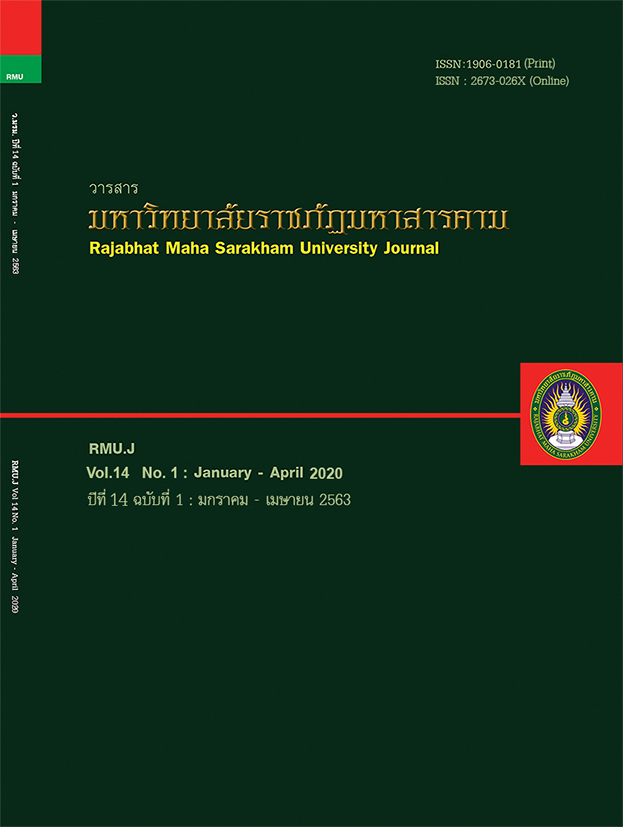Improvement of English Reading Comprehension by Using The Jigsaw Technique for Grade6 students
Main Article Content
บทคัดย่อ
The aims of the research were to 1) to study the effectiveness index (E.I.) of reading comprehension ability lesson plan based on the jigsaw technique, 2) to compare the achievement reading comprehension ability before and after learning by the jigsaw technique, and 3) to study the attitudes of students toward learning by using the jigsaw technique. The participants were 20 Grade6 students during the second semester of the 2017 academic year at KhokKhonWittayakom School; primary school in Kalasin province, in the northeastern of Thailand. The research instruments used in the study were (1) The Jigsaw Technique Instructional Plan, (2) Achievement test, and (3) Satisfaction questionnaire. Mean and standard deviation were used to analyze, and compare the pre- and post- test scores by t-test.
The research results found that (1) the English reading comprehension ability of students after used the instructional plans rose up at 0.6371 level or 63.71%, (2) the students’ mean score on the pretest and posttest in English reading comprehension skill improved from 13.05 (pretest) to 23.85 (posttest) score with statistically significance at 0.05 level, and (3) The students were satisfied in learning English reading comprehension through the Jigsaw Technique.
Article Details
1. บทความที่ลงตีพิมพ์ทุกเรื่องได้รับการตรวจทางวิชาการโดยผู้ประเมินอิสระ ผู้ทรงคุณวุฒิ (Peer Review) สาขาที่เกี่ยวข้อง อย่างน้อย 3 ท่าน ในรูปแบบ Double blind review
2. ข้อคิดเห็นใด ๆ ของบทความที่ลงตีพิมพ์ในวารสารมหาวิทยาลัยราชภัฏมหาสารคาม นี้เป็นของผู้เขียน คณะผู้จัดทำวารสารไม่จำเป็นต้องเห็นด้วย
3. กองบรรณาธิการวารสารมหาวิทยาลัยราชภัฏมหาสารคาม ไม่สงวนสิทธิ์การคัดลอกแต่ให้อ้างอิงแสดงที่มา
เอกสารอ้างอิง
Aronson, J. (1978). Exploring second language reading: Issues and strategies. Boston, USA: Heinle & Heinle Publishers.
Clarke, J. (1999). Pieces of the puzzle: The jigsaw method. In Handbook of Cooperative Learning Methods, ed.
Ellis, R. (2010). Task-based language learning and teaching. New York: Oxford University Press.
Fowle, C. (2000). Developing a reading habit with Thai young learners. The English Teacher: An international Journal. 5(1), 18-19.
Hevedanli, M., & Akbayın, H. (2006). The Effects of cooperative learning on students’ achievement, retention and attitudes in biology teaching. D. Ü. Journal of Ziya Gökalp Education Faculty. 6,21 - 31.
Johnson, D. (2005). Cooperative Learning : Increasing College Faculty Instructional Productivity. n.d. January 15.
Qiao, M. and Jin, X. (2010). Jigsaw strategy as a cooperative learning technique: focusing on the language learners. Chinese Journal of Applied Linguistics. 33(4): Harbin Institute of technology.
Siriwan, M. (2012) Understanding the Cooperative Learning Dimension. International Conference on Sciences and Social Sciences 2012: Innovation for Regional Development (ICSSS 2012). Rajabhat Maha sarakham University.
Jacobs, G.M. and Kline Liu, K. (2015). Integrating language functions and collaborative skills in the second language classroom. New York: Oxford University Press.
Schiefele, U. (1991). Interest, learning, and motivation. Educational Psychologist. 26, 299 - 323.
Somnuk Patthiyatane. (2003). Educational Measurement. Chulalongkorn University Press.
Srisa-ard, B. (2011). Preliminary research. 7thed. Bangkok: SuweeriyaSarn.
Paisarn Worakham. (2015). Research and development of Inculcation process for future agriculturist. International Journal of GEOMATE.
Shaaban, K. (2006). An Initial Study of the Effects of Cooperative Learning on Reading Comprehension Vocabulary Acquisition and Motivation to Read. Reading Psychology. 27, 377 - 403.
DOI: 10.1080/02702710600846613.
Tardtong, K. (2009). Classroom Management: Happiness Classroom. Bangkok: Petchakasemprinting.
Rubin, J. and Thompson, I. (1994). How to be a more successful language learner: Toward learner autonomy. (2nd ed.). Boston, MA: Heinle & Heinle. Rudska,


